
Writing is one of the greatest inventions in human history. The interest in knowing the origin of writing comes from very distant times. Writing, in advanced cultures like ancient Egypt, was considered sacred. In China, a very special cult was also paid to him. In this article we will tell you about the History of writing for children.
Why was Writing First Invented?
Table of Contents
Representing the sounds of the human voice on a “support” or material was not an easy task. Writing is believed to have originated approximately five thousand years ago, due to the need to record numerical operations as a primitive form of accounting. The Sumerians first invented writing as a means of long-distance communication which was necessitated by trade.
Writing is called the representation of words or ideas of a language, by means of graphic symbols engraved or drawn on a support.
What is a Writing System?
A writing system is an organized method of storing and transferring messages through a language. Typically, writing systems are visual, made up of a set of signs and symbols, known as characters. There are also tactile reading-writing systems, such as the Braille system that is used for people who cannot see, called the blind or blind.
Birth of Writing
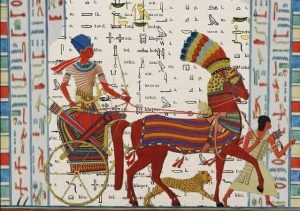
Writing was not always as we know it today. Ancient peoples represented words or situations with pictures called pictograms. The writing was evolving in three stages: the pictographic, the ideographic and the phonetic.
Origin and Evolution of Writing Systems
Pictography is a form of writing through which ideas are transmitted through drawing. They are images that are used to represent certain words or ideas.
History of Pictograms and Ideograms

What are Pictograms?
Pictograms are symbols that represent objects and situations. Pictograms appeared before ideograms. Since they were not easy to form sentences, they began to use triangular shapes to symbolize sounds, which they could then use to spell words. Some ways mean words, other ideas, or situations.
The Development of Writing in Mesopotamia
Difference Between Pictograms and Ideograms
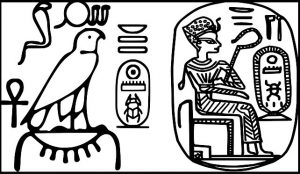
Is a Pictogram the same as an Ideogram? What is an Ideogram?
Ideograms are graphical symbols that represent an idea or concept. Ideograms are formed by the combination of pictograms, they are characters that indicate an idea through its graphic representation. Ideograms were later than pictograms. Examples of Ideograms: traffic signs and mathematical symbols.
Ideograms: Examples
An example of both might start with a simple symbol that represents a roof: an inverted “V”. This would be a valid character to mean “house”. If a symbol for a woman was placed under this roof, the resulting character could well represent the idea of ”home” or “family.” In fact, in Chinese, a woman indoors can be used to mean “peace.”
Another type of play on words could include a sloping symbol representing the bank of a river under the same roof. The symbol that combines, roof and bank, would represent a financial institution, which for us is currently a “bank”.
Pictograms and ideograms are the basis of hieroglyphs and cuneiform writing.
The Cuneiform Writing System in Ancient Mesopotamia
This writing was spread among the Sumerian peoples, who inhabited Mesopotamia (present-day Iraq), Asia Minor, Syria and Persia. The original Sumerian writing system derives from a system of clay tokens, which were used to represent goods. Since in ancient times they did not have paper or ink, they used tools made of wood or rigid reeds that they pressed on soft clay tablets that they allowed to dry.
Its denomination of cuneiform, is due to the fact that the signs were written by the scribes by means of triangular wedges that were printed by rapid blows with a cane awl, on fresh clay tablets. They were kept in primitive libraries, scrupulously organized, which were used for the learning of future scribes. These libraries belonged to the school in each city or, sometimes, to private collections.
Who invented Writing?
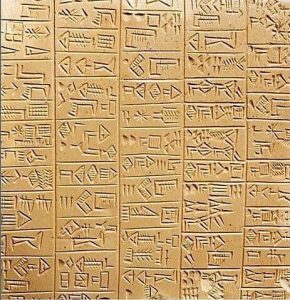
Epic of Gilgamesh
Cuneiform Tablet: Evolution of Writing.
Some tablets have survived over time and can now be seen in museums. The most complete collection of recognized cuneiform writing was found in the Library of Nineveh. Up to 22,000 tablets were collected, found under the rubble of the royal palace in Nineveh. One of the most famous works in the library is the Epic of Gilgamesh, considered to be the oldest narrative work of mankind.
The Sumerians invented the cuneiform language and the Babylonians and Assyrians continued to use it long after the Sumerians disappeared. Eventually, the use of cuneiform writing disappeared and was replaced by written languages.
History of Writing: Summary
But … Who invented writing?
Writing developed simultaneously in different parts of the world. No single origin is recognized. Apparently the first civilizations to write were the Sumerians and Egyptians, around 3500-3200 BC. C. (before Christ). Although it is not clear, which of those two peoples invented writing in the first place.
Both had known agriculture for a few thousand years and felt the need to record the agricultural products they produced.
Who Invented Writing?
It is not possible to attribute this invention to a specific civilization. Writing emerged in a variety of different cultures in the Bronze Age, meaning that it was invented simultaneously in various places.
History of Writing Systems
Sumerian, ancient Egyptian, Chinese and Mayan writing began with pictograms, objects were first drawn and then replaced by stylized shapes.
Egyptian Hieroglyphs
In ancient Egypt, the job of scribes was to write up events. They did it using a system of images or pictograms. These images were called hieroglyphs. It was a beautiful art that was used to make inscriptions on monuments, pyramids, sarcophagi, tombs and sculptures. Most of the inhabitants could not read hieroglyphs, it was exclusive to priests, army officers, officials, scribes and pharaohs. It had sacred value, since it was known as the “language of the gods.”

What does the word hieroglyph mean?
Hieroglyphs is made from two Greek words:
- hieros meaning holy
- glyphe meaning writing
Hieroglyph means: holy writing.
Egyptian Hieroglyphs and their Meaning
Hieroglyphic Writing. Hieratic Script
The Hieratic Script appears because it was not easy to write the hieroglyphs with calamus on papyri. This type of writing is an abbreviated form of hieroglyphic and was used in a complementary way to it. The hieratic writing was more stylized, agile and simple, and was used by the scribes of Ancient Egypt to quickly write administrative and religious texts by simplifying the hieroglyphs. Its purpose was to write religious, administrative, scientific and literary texts. Therefore, it was commonly used by scribes and priests. Certain inscriptions on monuments were made in hieratic writing mainly for legal texts, lease contracts, letters, among others, and only clergymen had access to it.
Ancient Hieroglyphic Alphabet with examples
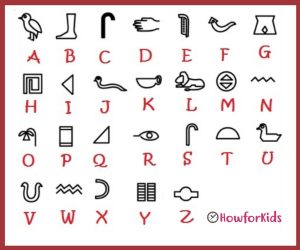
For this style of cursive writing, which apparently developed at the same time as the hieroglyphs, a sharp reed was used as a brush and black ink. The red ink was reserved to highlight words or passages of the text. The texts were drawn in lines from right to left. It was considered a very useful graphic, to be drawn on papyri and ostraca with a blunt-tipped brush that was moistened in ink. The most used materials were papyrus and ostracas (ceramic fragments). Likewise, texts on linen, wood, stone and leather have also been discovered.
Difference between Hieratic and Demotic Writing
The hieratic script (from the Greek ‘’ hieratika ’’ which means priestly), is the cursive letter of the script, commonly used by the Egyptians. The main difference was the union between symbols, called ligature, which was widely used to form pairs or abbreviated groups of symbols in cursive writing.
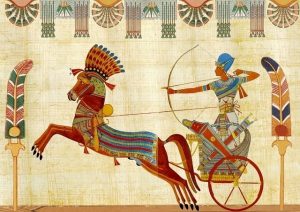
Around 660 BC the hieratic writing was replaced by the demotic one. In the period of Roman domination, all works of a funerary nature were written in hieratic or demotic
Since it took too long to write in hieroglyphics, the scribes needed a more agile and fast system. The Demotic Script is a writing system of the type of cursive, more simplified and with new signs, full of ligatures, abbreviations and other spelling peculiarities that were used for economic and literary purposes. It was a shortened form of hieratic and the last exclusively Egyptian type of writing. It was engraved on stone and wood unlike the Hieratic writing that was written on papyri and ostraca. It was the writing that was taught to the people and its use was for texts of the general public. It became the dominant script in Ancient Egypt around 600 BC. And at the beginning of the IV century, it was replaced by the Greek language in the official texts.
Egyptian Writing System
Fun Fact: How to Read Cuneiform
When modern language experts tried to read cuneiform writing, they found themselves puzzled. Thousands of years had passed since anyone had written or read cuneiform. Nobody in modern times knew what the symbols meant. Things changed, when Henry Rawlinson, a British officer in the 19th century, went on a field trip in Persia (now called the country of Iran). Rawlinson, saw an image carved into the rock of a high cliff. This image, told the story of an ancient king, his servants and some prisoners. The story was told in images and in cuneiform writing. Once they understood a few words in cuneiform script, they began to recognize the same symbol on tablets and documents. They were able to identify the meaning of other symbols and they were understanding. They worked very hard until they could read a great deal of cuneiform writing. The same thing happened in Egypt, when they found the Rosetta Stone, which helped scientists decipher ancient Egyptian hieroglyphs.
Read also: Latitude and Longitude
Fun Fact: The Rosetta Stone Key to Deciphering Hieroglyphs
The Rosetta Stone is one of the most important objects in the British Museum as it holds the key to understanding Egyptian hieroglyphs. The Rosetta Stone was discovered in 1799, during the Napoleonic campaign in Egypt, inscribed with three versions of a decree issued in Memphis, Egypt in 196 BC. during the dynasty of King Ptolemy V. This black stone, made of a material called basalt, contained inscriptions in different languages. The upper and middle texts are in ancient Egyptian using hieroglyphic writing, demotic writing, respectively, while the lower part is in ancient Greek. It was the first recovered Ancient Egyptian trilingual text to arouse wide public interest with its potential to decipher this previously untranslated hieroglyphic language. The original stone has been on public display in the British Museum almost continuously since 1802, and is the most visited object.

The Story of The Rosetta Stone
Who finally broke the code by translating the Rosetta Stone?
Who deciphered hieroglyphics?
The Frenchman Jean-François Champollion (1790-1832) in 1822, after long years of intense work and many setbacks, managed to decipher the hieroglyphic writing, through the study of the Rosetta Stone. His success was due to the fact that he recognized that hieroglyphic writing, (as well as hieratic and demotic), did not constitute a symbol writing system, but a phonetic writing. He was comparing Egyptian, hieratic, and demotic writing with the Greek alphabet, which was legible at that time. Champollion correctly determined the phonetic values of the signs. Soon after, he learned to read and translate a large number of Egyptian words. Since then, research has confirmed Champollion’s approach and most of the results from him.
What are Mayan writing symbols called?
The History of Writing: The Mayans
Of the three main cultures of pre-Columbian America (Incas, Aztecs, Mayas) the Mayan people were the first to create a pictographic writing similar to that of Egypt. The Mayans created a writing system using symbols called glyphs. Each symbol represented a word or a sound. The Mayans also created books, known as codices. They developed a glyph-based writing system, unique in the entire American continent. These Mayan hieroglyphs are distinguished from the other cultures of pre-Columbian Mesoamerica (Incas, Aztecs, Toltec Mayas, Olmeca, Zapotec, others) by the characteristics and complexity of the illustrations and by the number of signs that were used. It originated due to the need to record astronomy data, numerical data, proper names, places, dates, mathematical data, medicine, art, historical events, laws.
Mayan Numbers
The Mayans were great scientists and mathematicians. They knew the zero concept and used a vigesimal system, which means that they had 20 elements. The number system was formed from 3 symbols.
The Mayan writing system was carried out by means of logograms and syllabic glyphs, very similar to the type of oriental writing. The act of writing and reading at this time was the exclusive privilege of priests, who made the codices and laws. The sacred books of the Mayans were mostly destroyed with the arrival of the Spanish.
Read also: The Mayans for Kids
Characteristics of the Mayan Writing
The Mayan writing was a very complete system based on phonetic signs. They were written with vegetable paintings on tree bark leaves, scrolls of animal skins such as deer and jaguars. They had multiple uses: carvings to decorate walls, ceilings and clay, wood, bone and stone crafts for personal adornments.
While phonetic signs are used in our writing system, it seems comparatively much simpler than the Maya system. Our alphabet consists of 26 signs and the Mayan syllabary gives rise to all Mayan words by the combination of 800 signs in which each sign represents one syllable. The Mayans grouped writing in blocks of columns, the glyphs were organized from top to bottom and from right to left, each block corresponds to a verb.
Chinese Writing
Chinese writing has advanced much further down the path of ideographic notation than other types of writing. This language is characterized by representing complete words or ideas. The most primitive symbols in the history of ideographic writing and its origins resemble Egyptian and Mayan writing, which was also based on pictorial representation and with the use of geometric figures. This Chinese writing system was characterized by graphic signs found on turtle shells and on bones or archaeological remains.
Origin of Chinese Writing. History of Chinese Writing
The earliest known inscriptions were used for divination and belonged to the Shang dynasty (1765–1122 BC). It was a highly developed system, for the time, similar to its current form. These inscriptions were, for the most part, instruments of divination in which a question was asked aloud about issues that concerned the rulers. Heat was applied to incisions made in bones, causing them to crack. Subsequently, the interpretation of the cracks was made, and the date, the name of the fortune-teller, the number of cracks, the question asked by the oracle, its interpretation and whether the inscription had been completed were recorded on the same shell or bone. In short, the writing on oracle bones was used as a vehicle to contact the gods and to record memorable events.
Characteristics of Chinese Writing
By 1400 BC the writing included about 2,500 to 3,000 characters, most of which can be read today. The pictograms represented simple ideas of nature such as the sun or the moon.
The characters of Chinese writing share common features that make it unique. Some are simple since they only consist of two or three strokes, unlike others that go up to fifty strokes, but all must occupy the same graphic space.
When observing a text in Chinese, it is perceived that the curves practically do not exist and the great majority of the features are rectilinear. This is explained because they needed to write on turtle bones or shells with an awl or some rigid writing implement.

